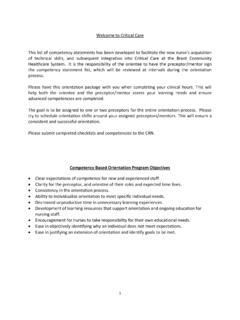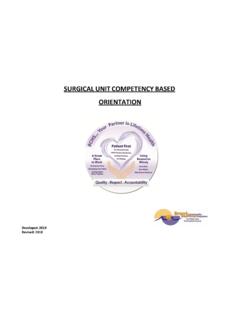Transcription of Emergency Department Core Competencies, Skills ... - BCHS
1 Emergency Department Core Competencies, Skills Checklist, and Development Tool Updated September 2015 Page 1 of 27 Emergency Department Core Competencies, Skills Checklist, and Development Tool Emergency nursing is a specialty within the nursing profession. By definition, Emergency nursing is the care of individuals of all ages with perceived or actual physical or emotional alterations of health that are undiagnosed or require further interventions. Emergency nursing care is episodic, primary, and usually acute. ( Emergency Nurses Association, 2003). A competency is an expected level of performance that integrates knowledge, Skills , abilities, and judgement. The expected level of performance for an Emergency nurse is fluid in its progression from novice to expert based on the nurse s level of learning and experience. (National Emergency Nurses Association, 2012).
2 Using Benner s Stages of Clinical Competence, please give yourself a rating on the outlined Emergency Department core competencies and Skills . 1. Novice No experience 2. Advanced Beginner Knowledge is developing and demonstrates acceptable performance; has had some real life experience but Requires cueing and support from mentor 3. Competent Typically 2-3 experience in one area; lacks speed and flexibility of a proficient nurse but has some mastery and can rely on Planning and organizational Skills 4. Proficient Perceives and understands situations as whole parts; achieved independence in performing the skill(s) 5. Expert Performance is now fluid, flexible and highly proficient; operates from a deep understanding of the total situation References: Brant Community Healthcare System. (2014). Orientation Package Emergency Room. Emergency Nurses Association.
3 (2003). Sheehy s Emergency Nursing Principles and Practice (5th Ed.). Mosby, Inc., St. Louis, MO. Emergency Nursing Certification Blueprint and Specialty Competencies. Canadian Nurses Association, 2012. Web. 22, July 2015. Huron Perth Healthcare Alliance. (2014). Clinical Competency Package HPHA RN s in the Emergency Department . Emergency Nursing Core Competencies. National Emergency Nurses Association, 2014. Web. 22, July 2015. Emergency Department Core Competencies, Skills Checklist, and Development Tool Updated September 2015 Page 2 of 27 Criteria Clinical Competence Date: 1 2 3 4 5 Initials Clinical Competence Date: 1 2 3 4 5 Initials Recommended Learning Strategies Respiratory Primary Assessment of the respiratory system IPPA *Definition: I Inspection P Palpation P Percussion A Auscultation* Identify normal breath sounds during a respiratory assessment Identify abnormal breath sounds during a respiratory assessment Assessment of airway to determine patency Assessment of effective versus ineffective ventilations Demonstrate the skill of setting up different oxygen therapy adjuncts.
4 Knowing when to administer oxygen, the amount and by the appropriate means: o Adult nasal prongs o Adult NRB o Venti-mask concentrations o Pediatric nasal prongs o Pediatric NRB o Bag valve mask o BiPap/Non-Invasive Ventilation Demonstrates the skill of insertion of an oral &/or nasopharyngeal airway Demonstrates the ability to suction: o Orally o Nasopharyngeal o Tracheal o Inline Demonstration of non-invasive positioning to clear and open airway: o Head tilt chin lift &/or jaw thrust Emergency Department Core Competencies, Skills Checklist, and Development Tool Updated September 2015 Page 3 of 27 Criteria Clinical Competence Date: 1 2 3 4 5 Initials Clinical Competence Date: 1 2 3 4 5 Initials Recommended Learning Strategies Identify the location of the following respiratory equipment: o Glidescope o Ventilator o BiPap o EtCO2 monitor o Difficult intubation cart o Laryngoscope blades (MAC curved.)
5 Miller straight) Demonstrate the ability to care for the patient on a BiPap/CPAP machine Demonstrates the ability to collect, interpret and evaluate data related to the respiratory system: o Lab results o ABG s (interpret and evaluate only) o Peak flow measurements o ECG s o End tidal CO2 (interpret and evaluate only) o Oxygen saturation Demonstrates the ability to care for the intubated/ventilated patient: o Indications for intubation o Post intubation diagnostics (PCXR) o Maintenance: Oxygenation (PEEP, FiO2) Patient positioning Suctioning o Selects appropriate interventions to promote successful ventilation Pain management Sedation Emergency Department Core Competencies, Skills Checklist, and Development Tool Updated September 2015 Page 4 of 27 Criteria Clinical Competence Date: 1 2 3 4 5 Initials Clinical Competence Date: 1 2 3 4 5 Initials Recommended Learning Strategies Rest Demonstrates ability to assist, set up and monitor: o Chest tubes o Supraglottic airways o Cricothyrotomy &/or Emergency tracheostomy o Intubation Demonstrates ability to administer and monitor pharmacological agents related to the respiratory system: o Bronchodilators o Steroids o Thrombolytic agents o Analgesics o Reversal agents o Sedatives o Neuromuscular blocking agents *See list of commonly used medications Demonstrates the ability to identify and assist with appropriate interventions with actual or potential life threatening alterations in respiratory function(including but not limited to).
6 O Pulmonary embolism o Inhalation injuries (gases, chemical, smoke, thermal) o Asthma, status asthmaticus o Chronic obstructive pulmonary disease (COPD) o Pneumonia o Pulmonary edema o Respiratory arrest o Bronchitis, acute bronchitis, respiratory syncytial Emergency Department Core Competencies, Skills Checklist, and Development Tool Updated September 2015 Page 5 of 27 Criteria Clinical Competence Date: 1 2 3 4 5 Initials Clinical Competence Date: 1 2 3 4 5 Initials Recommended Learning Strategies virus (RSV) o Partial or complete airway obstruction (tongue, epiglottitis, foreign bodies, angioedema, croup, mucous plugs) o Blunt or penetrating chest trauma o Pneumothorax (tension vs spontaneous) Cardiovascular/Circulatory Primary assessment of the cardiovascular system - IPA Interprets and evaluates data related to the cardiovascular system including: o Bloodwork results (CK, troponin, coagulation, lactate) o Physical assessment data ( indications for a bilateral blood pressure, peripheral and central pulses, heart sounds, vital signs) Demonstrate the skill of performing a 12 and 15 lead ECG and identify the indications for a 15 lead ECG Refer to BCHS policy: ECG 12 Lead Rt.
7 Sided: Posterior Leads 12 & 15 Lead Identify an acute inferior, anterior, lateral, and posterior wall MI on a 12 lead ECG Refer to BCHS policy: ECG Interpretation Identify priorities of care for the patient having an MI o STEMI protocol for transfer to HGH HIU o STEMI protocol - pharmacological TNK o NSTEMI Demonstrate competent use of the ED cardiac bedside monitors, the central station, and the Phillips defibrillation monitors, application of 3 &/or 5 lead chest placement for both adult and pediatric patients Refer to BCHS policy: Cardiac Monitoring Demonstrates the ability to interpret cardiac arrhythmias and identify those which are life threatening, as well as nursing interventions for the Emergency Department Core Competencies, Skills Checklist, and Development Tool Updated September 2015 Page 6 of 27 Criteria Clinical Competence Date: 1 2 3 4 5 Initials Clinical Competence Date: 1 2 3 4 5 Initials Recommended Learning Strategies following: o Atrial tachycardia o Bradycardia o Junctional and ventricular arrhythmias o PSVT o 1o heart block o 2o heart block Mobitz I o 2o heart block Mobitz II o 3o heart block Differentiate between defibrillation and synchronized cardioversion and discuss indications for use for both forms of energy delivery Refer to BCHS policies: Cardioversion.
8 Defibrillation Demonstrates the knowledge of appropriate nursing care for the patient before, during, and after synchronized cardioversion Identifies indication for external pacing Identifies paced beats on a rhythm strip Demonstrates the ability to analyze a 6 second cardiac monitor strip, can identify: o P wave o PR interval o QRS o T wave o QT interval Demonstrates the ability to participate in a cardiac arrest event Demonstrates the ability to prioritize assessment and interventions to care for the patient with return of spontaneous circulation (ROSC) Performs and maintains peripheral IV access o Adult Refer to BCHS policy: Intravenous Therapy Emergency Department Core Competencies, Skills Checklist, and Development Tool Updated September 2015 Page 7 of 27 Criteria Clinical Competence Date: 1 2 3 4 5 Initials Clinical Competence Date: 1 2 3 4 5 Initials Recommended Learning Strategies o Pediatric Assist with insertion and maintenance of intraosseous access Understands principles of rapid fluid administration Demonstrates the ability to use the current ED rapid fluid administration device Demonstrates understanding of and utilizes principles of monitoring of patient during blood and blood product transfusion: o PRBC o FFP o Platelets o Immune globulin o Octaplex o Albumin Competency checklist: Blood Product Administration Checklist Demonstrates use of blood/fluid warmer Refer to BCHS policy: Warming of IVF/Blood Identifies blood transfusion reactions and nursing responsibilities Assists with the insertion of central lines o Demonstrates skill of setting up central venous access device equipment Demonstrates the ability to care for central venous access devices.
9 O Explain indication of use and sites o States complications of CVAD s o Explains indications for post insertion x ray Refer to BCHS policy: Intravenous Therapy Self-directed learning package: Management of Central Venous Access Devices (CVAD) Demonstrate the skill to access CVAD s for intravenous therapy Refer to BCHS policy: Intravenous Therapy Demonstrates the skill to obtain blood sampling from: o Percutaneous CVAD o Implanted CVAD Refer to BCHS policy: Intravenous Therapy Competency checklist: PICC Line Dressing Change/Cap Change Emergency Department Core Competencies, Skills Checklist, and Development Tool Updated September 2015 Page 8 of 27 Criteria Clinical Competence Date: 1 2 3 4 5 Initials Clinical Competence Date: 1 2 3 4 5 Initials Recommended Learning Strategies o Peripherally inserted central catheter (PICC) Demonstrates the ability to identify and assist with appropriate interventions with actual or potential life threatening alterations in cardiovascular and circulatory functions (including but not limited to): o Acute coronary syndrome (angina, ischemia, infarction) o Cardiac tamponade o Cardiogenic shock o Hypovolemic shock o Obstructive shock o Distributive shock (anaphylactic, septic, neurogenic) o Congestive heart failure o Hypertensive crisis o Aortic aneurysm (aortic and thoracic) o Pericarditis, myocarditis, endocarditis o Cardiomyopathy Demonstrates ability to administer and monitor pharmacological agents related to the cardiovascular system.
10 O Nitrates o Anticoagulants o Thrombolytic/fibrinolytic agents o Inotropes o Antihypertensives o Antiarrhythmic agents o Antiplatelet agents o Antibiotics o Analgesics Emergency Department Core Competencies, Skills Checklist, and Development Tool Updated September 2015 Page 9 of 27 Criteria Clinical Competence Date: 1 2 3 4 5 Initials Clinical Competence Date: 1 2 3 4 5 Initials Recommended Learning Strategies Neurological Primary assessment of the neurological system - IPA Demonstrates the ability to perform a neurological assessment using: o Glasgow coma scale (GCS) o Canadian neurological scale (CNS) o National Institute of Health Stroke Scale (NIHSS) Refer to BCHS policy: Canadian Neurological Scale Demonstrates the ability to assess level of consciousness Demonstrates application of cervical collar Assists with maintenance of spinal stabilization and immobilization Demonstrates ability to evaluate pain using appropriate pain scale o Likert numerical scale o FACES scale for pediatrics Evaluates and understands data related to the neurological system: o Vital signs o Lab tests (CSF, electrolytes, ABG s) o Diagnostic tests (CT scans, MRI, EEG) o Capillary blood glucose Identifies priorities for patients presenting with hyper acute stroke symptoms: o Stoke protocol o Indications for a stroke protocol o tPA administration o Post medication administration monitoring Refer to BCHS policies: Inpatient Stroke Protocol.







